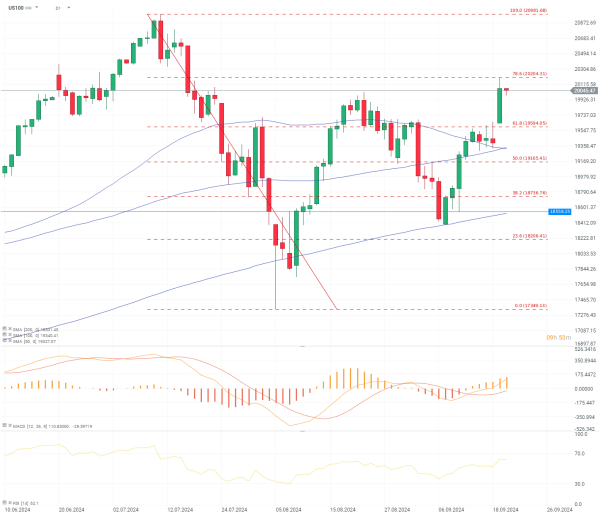Chart of the day - US100 (20.09.2024)
The Federal Open Market Committee (FOMC) decision to cut rates 50 basis points might have surprised the economists, however it is a good sign for technological companies. As could be seen in March 2020 when tech stocks have rallied. This time we enter monetary policy easing with constantly developing Artificial Inteligence tools and use cases.
The Nasdaq has historically performed well following Fed rate cuts, as seen after the March 2020 reductions. However, the current situation presents unique challenges. The Nasdaq has surged to around reflecting the market's positive reaction to the rate cut. The 50 basis point cut, being larger than the typical 25 basis point adjustment, could be interpreted as a sign of the Fed's confidence in the economy's strength, potentially providing higher upside for the tech-heavy index based on the lower cost of capital.
September has historically been a seasonally weak month for the Nasdaq, with an average monthly return of -1.5%. However, October has been one of the best months historically, which could pair well with this significant softening of monetary policy.
Investors should prepare for increased volatility in the coming days as the market fully digests the FOMC announcement and subsequent press conference. The Fed's forward guidance and updated dot plot are critical in shaping market sentiment beyond the immediate rate decision. Tech stocks, particularly those of large-cap companies like Apple, Microsoft, and Nvidia, are likely to be especially sensitive to the Fed's commentary and future outlook.
US100 (D1 interval)
The US100 contract closed yesterday above the 61.8% Fibonacci retracement and is currently trading above it. The first resistance for bulls is the 78.6% Fibonacci retracement at 20,204. Breaking this level could open a path to retesting the all-time high. For bears, the key support level is at the 61.8% Fibonacci retracement. If this is broken, the 50- and 100-day SMAs might be tested. Currently, the RSI shows clear bullish divergence, while still being below oversold territory, and the MACD is slowly indicating a bullish signal.
